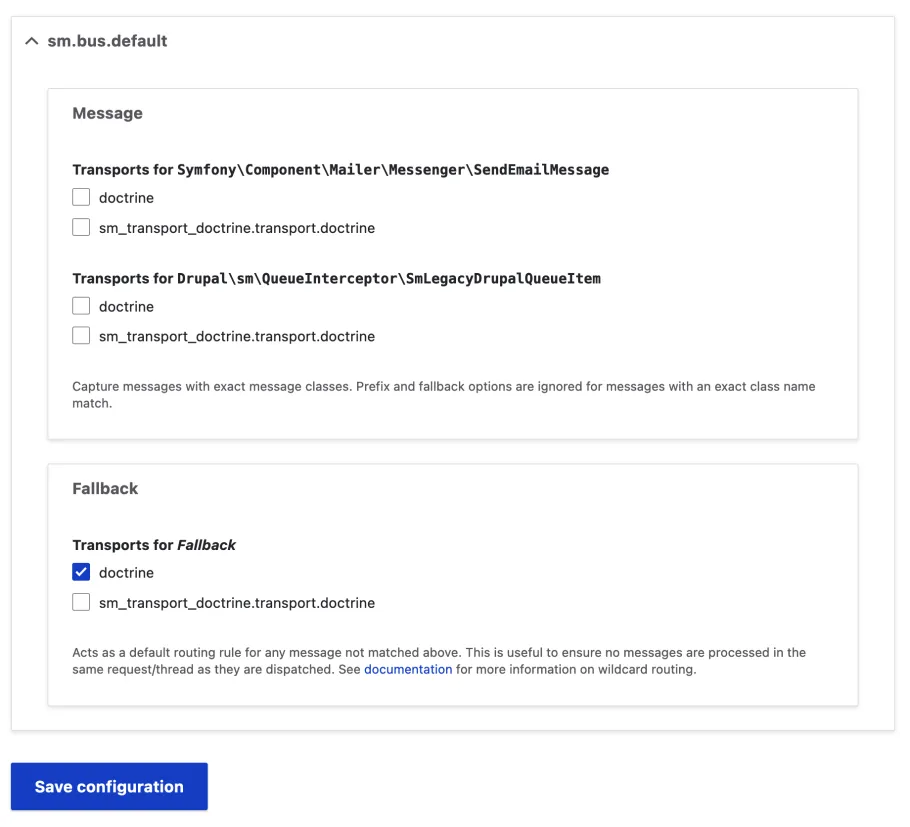
Daniel PhinDeveloper
This post covers Symfony Messenger’s message and message handlers, which are the day to day code developers using features of Symfony Messenger typically will be working on.
This post is part 2 in a series about Symfony Messenger.
The Symfony Messenger integration with Drupal provided by the SM project is the only requirement for the following examples.
A message itself is very flexible, as it doesn't require annotations, attributes, or specific class namespace. It only needs to be a class serialisable by Symfony. For simplicity, don’t include any complex objects like Drupal entities. Opt to store entity UUIDs instead.
At its most simple implementation, a message handler is:
Messenger\ namespace#[AsMessageHandler] class attribute__invoke method. Where its first argument is an argument typehinted with the message class.Example message and message handler:
namespace Drupal\my_module;
final class MyMessage {
public function __construct(public string $foo) {}
}
namespace Drupal\my_module\Messenger;
use Drupal\Core\State\StateInterface;
use Symfony\Component\Messenger\Attribute\AsMessageHandler;
#[AsMessageHandler]
final class MyMessageHandler {
public function __construct(StateInterface $state) {}
public function __invoke(\Drupal\my_module\MyMessage $message): void {
// Do something with $message.
$this->state->set('storage', $message->foo);
}
}And dispatch code:
$bus = \Drupal::service(\Symfony\Component\Messenger\MessageBusInterface::class);
$bus->dispatch(new MyMessage(foo: 'bar'));Non-autowirable dependency injection
Message handlers use autowiring by default, so you don’t need ContainerFactoryPluginInterface and friends.
In the rare case that dependencies are not autowirable, you can opt to define a message handler as a tagged service instead of a class with #[AsMessageHandler] attribute and define dependencies explicitly. The same __invoke and argument typehinting semantics apply.
services:
my_module.my_message_handler:
class: Drupal\my_module\Messenger\MyMessageHandler
arguments:
- '@my_module.myservice'
tags:
- { name: messenger.message_handler }
Typically, when setting up a Drupal queue, you’ll be putting together a rigid class with a verbose annotation. When compared to the functionality of the messenger and handler above, the equivalent @QueueWorker looks like:
namespace Drupal\my_module\Plugin\QueueWorker;
use Drupal\Core\Plugin\ContainerFactoryPluginInterface;
use Drupal\Core\Queue\QueueWorkerBase;
use Drupal\Core\State\StateInterface;
use Symfony\Component\DependencyInjection\ContainerInterface;
/**
* @QueueWorker(
* id = "my_module_queue",
* title = @Translation("My Module Queue"),
* cron = {"time" = 60}
* )
*/
final class MyModuleQueue extends QueueWorkerBase implements ContainerFactoryPluginInterface {
private function __construct(
array $configuration,
$plugin_id,
$plugin_definition,
private StateInterface $state,
) {
parent::__construct($configuration, $plugin_id, $plugin_definition);
}
public static function create(ContainerInterface $container, array $configuration, $plugin_id, $plugin_definition): static {
return new static(
$configuration,
$plugin_id,
$plugin_definition,
$container->get('state'),
);
}
public function processItem(mixed $data): void {
// Do something with $data.
$this->state->set('storage', $data['foo']);
}
}And dispatch code
\Drupal::service('queue')
->get('my_module_queue')
->createItem(['foo' => 'bar']);Notice the hard-to-remember annotation, boilerplate dependency injection, and mixed-type processItem argument $data . In comparison, Symfony Messenger messages and message handlers are easier to use thanks to PHP attributes.
All messages will be handled synchronously by default. To route messages to specific transports, routing needs to be configured.
Behind the scenes, routing is a simple map of class/namespaces to transports defined in a container parameter.
parameters:
sm.routing:
Drupal\my_module\MyMessage: doctrine
Drupal\my_module\MyMessage2: synchronous
'Drupal\my_module\*': doctrine
'*': doctrineKeys are either verbatim class names, partial class namespace followed by asterisk, or a standalone asterisk indicating the fallback. The values are the machine name of a transport. SM includes a synchronous transport out of the box, which indicates messages are handled in the same thread as it is dispatched. The doctrine database transport is available as a separate module. I’d recommend always using an asynchronous transport like Doctrine.
SM includes a configuration UI submodule that allows site builders to build a routing map without needing to mess with YAML. The container parameter is set automatically as soon as the form is saved.

A common use case for adding stamps to a message is to delay the message for an amount of time. A stamp is created and attached to the envelope containing the message to be processed:
$envelope = new Envelope(
message: new MyMessage(foo: 'bar'),
stamps: [\Symfony\Component\Messenger\Stamp\DelayStamp::delayUntil(new \DateTimeImmutable('tomorrow'))],
);
$bus = \Drupal::service(\Symfony\Component\Messenger\MessageBusInterface::class);
$bus->dispatch($envelope);For more advanced use cases, multiple handlers can be configured for a message. Useful if you want to listen for messages that you do not own. For example, additional handling of the Symfony Mailer email message:
namespace Drupal\my_module\Messenger;
use Symfony\Component\Messenger\Attribute\AsMessageHandler;
use Drupal\Core\State\StateInterface;
#[AsMessageHandler]
final class MyMessageHandler {
public function __construct(StateInterface $state) {}
public function __invoke(\Symfony\Component\Mailer\Messenger\SendEmailMessage $message): void {
$this->state->set(
'sent_emails_counter',
$this->state->get('sent_emails_counter', 0) + 1,
);
}
}Both this custom handler and the original \Symfony\Component\Mailer\Messenger\MessageHandler::__invoke handler will be invoked.
Handlers can be configured to handle multiple message types. Instead of using the #[AsMessageHandler] attribute on the class, use it with methods.
namespace Drupal\my_module\Messenger;
use Drupal\Core\State\StateInterface;
use Symfony\Component\Messenger\Attribute\AsMessageHandler;
final class MyMessageHandler {
#[AsMessageHandler]
public function myHandler1(\Drupal\my_module\MyMessage $message): void {
// Do something with $message.
}
#[AsMessageHandler]
public function myHandler2(\Drupal\my_module\MyMessage2 $message2): void {
// Do something with $message2.
}
}The next post covers the worker, the heart of messenger’s real-time capabilities.
Part one in a series of posts introducing Symfony Messenger, its ecosystem, and unique Drupal integrations to Drupal developers.
The greatest advantage of Symfony Messenger is arguably the ability to send and process messages in a different thread almost immediately. This post covers the worker that powers this functionality.
Symfony Scheduler provides a viable replacement to hook_cron wherein messages can be scheduled for dispatch at a predefined interval. Messages are dispatched the moment they are scheduled, and there is no message duplication, making tasks more reliable and efficient.